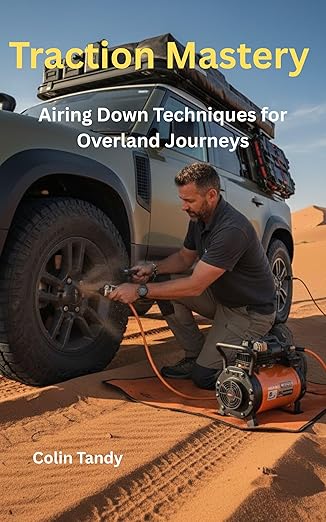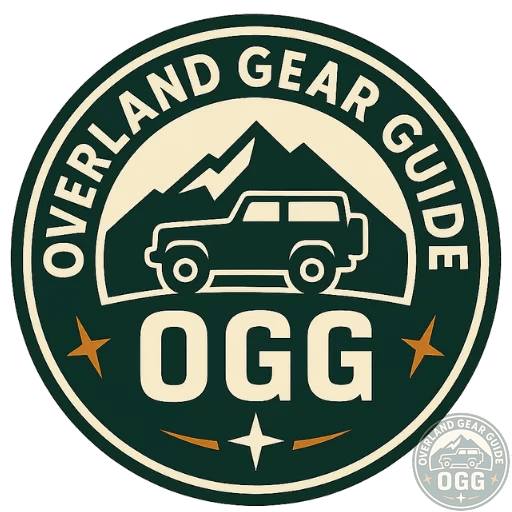Terrain-Specific Pressures: Sand, Mud, Rock, Gravel & Snow

Use this guide to set smart starting pressures for each surface, then fine-tune by rig weight and feel. Each section includes ranges, driving technique, failure modes, and quick field checks.
How to use this guide
- Start with the range for your terrain + rig weight (light <2.2t / medium 2.2–3.0t / heavy >3.0t).
- Drop in 2–3 PSI steps, drive 200–300 m, reassess steering feel, grip and sidewall bulge.
- Keep speeds low when aired down; reinflate for pavement and long hardpack transits.
Sand & Dunes (flotation first)
Soft sand demands a wide, gentle footprint so you ride on the surface. The goal is smooth, uninterrupted momentum.
| Rig weight | Typical PSI (all-terrain) | Notes |
|---|---|---|
| Light (<2.2t) | 12–16 PSI | Go lower in powder dunes; avoid sharp steering inputs. |
| Medium (2.2–3.0t) | 14–18 PSI | Use gentle throttle; plan run-ups, don’t dig. |
| Heavy (>3.0t) | 16–20 PSI | Watch sidewall heat; momentum > power; avoid sudden stops. |
Technique
- Stage run-ups straight; no sudden steering at crest.
- Commit to constant, light throttle; back out early if bogging.
- Use boards and a shovel before spinning.
Failure modes
- Wheelspin digs; avoid “roosting.”
- Over-steer at low PSI can roll a bead; slow steering at the top of dunes.
- Heat build-up on long beach transits — reinflate sooner.
Mud & Clay (tread evacuation)
You want the tread to clear and bite, not skate on packed lugs. Too low can fold sidewalls and feel vague.
| Rig weight | Typical PSI (A/T or M/T) | Notes |
|---|---|---|
| Light | 16–22 PSI | Keep some firmness for shoulder support and steering. |
| Medium | 18–24 PSI | Clean lugs with measured wheel speed, not revs. |
| Heavy | 20–26 PSI | Balance bite with sidewall protection; avoid lateral ruts. |
Technique
- Choose the highest, firmest line; straddle ruts where possible.
- Use steady throttle; a brief “cleaning” spin only if needed.
- Boards + static strap for repositioning beats burying it.
Failure modes
- Low PSI + camber = sidewall pinch or de-bead.
- Stopping in suction pits — plan exit before entry.
- Unrated tow points in sticky pulls — don’t use tow balls.
Rocks & Ledges (deformation & protection)
Use lower pressures to wrap tread over edges and increase contact at crawl speeds. Protect sidewalls and rims.
| Rig weight | Typical PSI (LT A/T or M/T) | Notes |
|---|---|---|
| Light | 14–18 PSI | Spot carefully; place shoulders away from sharp edges. |
| Medium | 15–20 PSI | Slow steering; avoid side-loads on off-camber faces. |
| Heavy | 16–22 PSI | Consider beadlocks for frequent crawling; keep speed to a walk. |
Technique
- Creep with smooth throttle; let tyres conform.
- Use a spotter; protect sidewalls from slicing rocks.
- Reset if scraping diffs repeatedly; build a small ramp.
Failure modes
- Rim strikes from speed — keep it crawl-pace.
- Bead unseating from lateral shock.
- Sidewall cuts on turned front tyres against rock.
Gravel & Corrugations (damping washboard)
A small reduction improves comfort and control by adding compliance, but watch heat and speed.
| Rig weight | Typical PSI (A/T) | Notes |
|---|---|---|
| Light | 24–30 PSI | Short sections only at moderate speeds. |
| Medium | 26–32 PSI | Mind tyre temps; extend sidewall life. |
| Heavy | 28–36 PSI | Err higher when loaded; reinflate for long transits. |
Technique
- Keep speeds conservative; don’t “skip” over corrugations.
- Brake early; loose marbles increase stopping distance.
- Check temps at breaks; hot sidewalls = reinflate.
Failure modes
- Heat build-up from extended speed at low PSI.
- Shoulder wear from long gravel miles underinflated.
- Hidden washouts — eyes up, scan further.
Snow & Ice (footprint + finesse)
Cold temps reduce pressure; aim for a longer, flatter patch and very gentle inputs. On ice, tyres need micro-slip, not spin.
| Rig weight | Typical PSI (A/T with winter-capable compound) | Notes |
|---|---|---|
| Light | 16–22 PSI | Feather throttle; avoid sudden steering. |
| Medium | 18–24 PSI | Use chains where legal for ice. |
| Heavy | 20–26 PSI | Weight helps, but manage momentum on descents. |
Technique
- Use 2nd-gear starts where possible to reduce torque shock.
- Brake early, straight; steer before you brake hard.
- Carry traction boards; they work brilliantly in snow.
Failure modes
- Spinning on ice polishes surface — stop, reset, add aids.
- Side-load bead unseat when cambered and very low PSI.
- Hidden ruts under powder — slow scan and probe.
Combined quick-reference
Air-Management Essentials
These two tools make pressure changes fast, accurate, and low-effort.
Staun Tyre Deflators — Australian Original (6–30 PSI, set-and-forget)

- FAST: Air down all four tyres from street to trail in minutes.
- AUTOMATIC: Clip on and walk away — stops at your set PSI (no valve-core removal).
- ADJUSTABLE: 6–30 PSI, factory set at 18 PSI (tweak anytime).
- CONVENIENT: Stand up while airing down; save your back and knees.
- COMPACT & ACCURATE: Made in Australia; proven for 20+ years.
EZ FLATE M.O.A.B. Auto Air Compressor (LCD, Target PSI, 10.6 CFM, 150 PSI)

- Auto Air Mode: Set a target pressure on the LCD — pumps and auto-stops when reached.
- Speed & Power: 10.6 CFM dual cylinders for large off-road tyres.
- Includes: Storage bag, 26′ hose, 5′ lead hose, gauge, and nozzle adapters.
- Easy to use: Clip to battery, connect hose, power on — done.
Disclosure: Some links are affiliate links. If you buy through them, we may earn a small commission at no extra cost to you.
📗 Traction Mastery: Airing Down Techniques for Overland Journeys

Unlock Your 4×4’s True Potential. The Most Powerful Upgrade Costs Nothing.
Go beyond guesswork with evidence-based techniques for sand, mud, rock, and snow — plus safe limits for any rig.
- Contact patch, flotation, mechanical grip — made simple.
- Terrain blueprints with starting pressures and adjustments.
- Toolkit picks and step-by-step procedures.
- Avoid de-beads, rim damage, and sidewall failures.
Authored by overlanding expert Colin Tandy. Perfect for first-time explorers and seasoned travelers alike.
© Overland Gear Guide — Tested in the field by real overlanders.


.png)